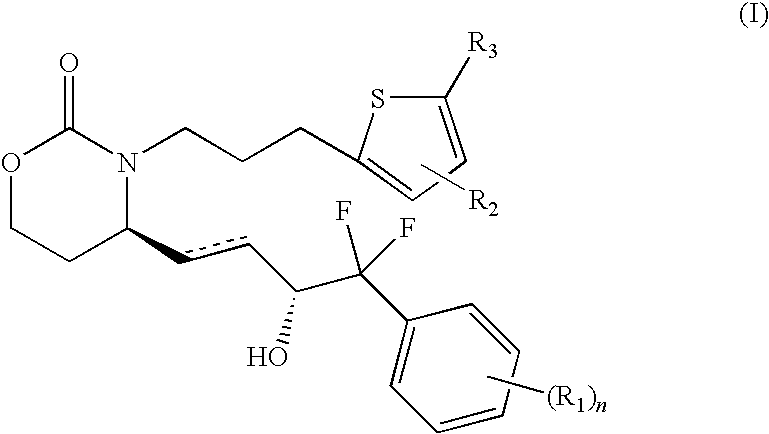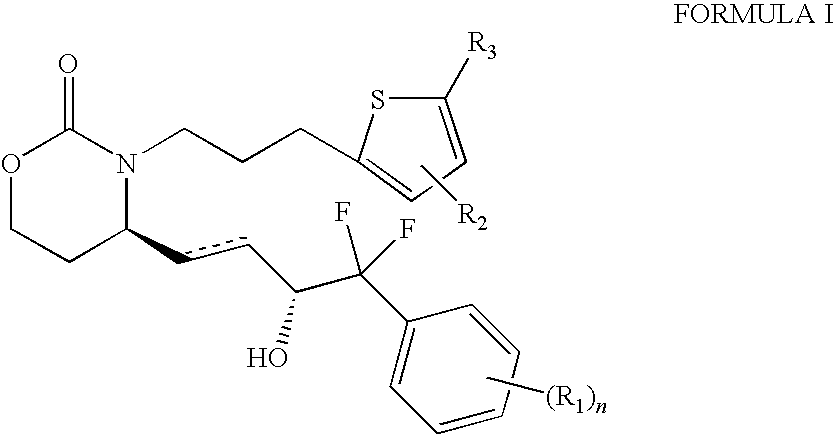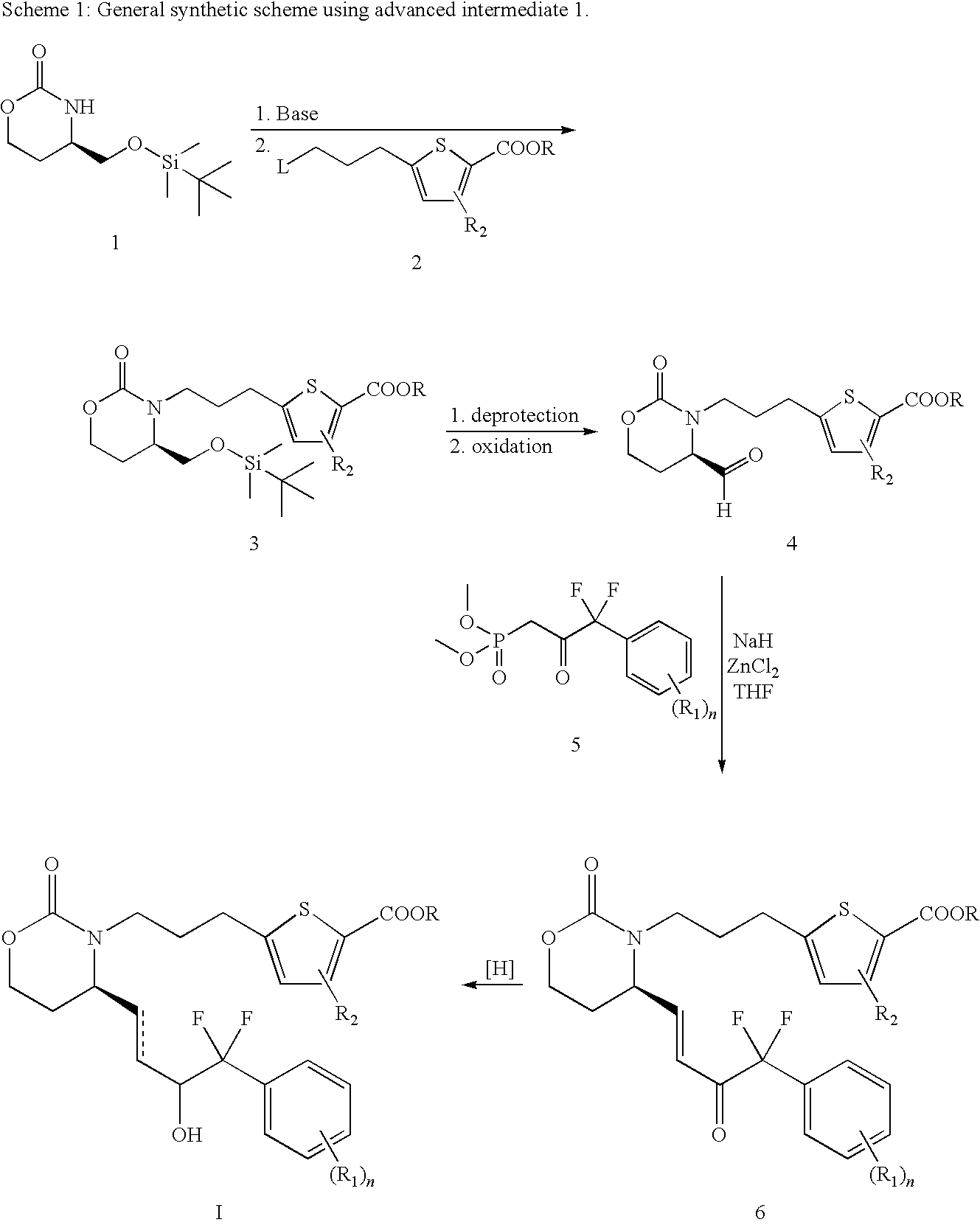EP4 Receptor Agonist, Compositions and Methods Thereof
a technology of ep4 receptor and composition, applied in the field of ep4 receptor agonist, can solve the problems of unsatisfactory glaucoma drugs, undesirable local effects, and irreversible loss of visual function, and achieve the effect of elevating intraocular pressur
- Summary
- Abstract
- Description
- Claims
- Application Information
AI Technical Summary
Benefits of technology
Problems solved by technology
Method used
Image
Examples
example 1
Isopropyl 5-(3-{(4R)-4-[(1E,3R)-4-(3-bromophenyl)-4,4-difluoro-3-hydroxybut-1-en-1-yl]-2-oxo-1,3-oxazinan-3-yl}propyl)thiophene-2-carboxylate
[0101]To a solution of ketone 11 (500 mg, 0.877 mmol) in DCM (5 ml) was added formic acid (52 μl, 1.31 mmol) and triethylamine (148 μl, 1.05 mmol) and the mixture was stirred at rt for 10 min. To it was then added Ru catalyst 14 (28 mg, 0.044 mmol) and the mixture was stirred at rt until all starting material was consumed by TLC analysis. The mixture was diluted with EA and washed with 1N HCl. The organic layer was dried, filtered and concentrated in vacuo and the crude was purified by flash chromatography (25-75% EA / hexanes) to give the desired product in a diastereomeric ratio of 10-40 / 1 in favor of the desired isomer. The diastereomeric mixture was further purified by chiral AD (30% i-PrOH / exanes) to give the title compound. 1H NMR δ (ppm)(Acetone-d6): 7.69 (2H, d, J=6.4 Hz), 7.62 (1H, d, J=3.7 Hz), 7.55 (1H, d, J=7.8 Hz), 7.45 (1H, t, J=8.2...
example 2
5-(3-{(4R)-4-[(1E,3R)-4-(3-bromophenyl)-4,4-difluoro-3-hydroxybut-1-en-1-yl]-2-oxo-1,3-oxazinan-3-yl}propyl)thiophene-2-carboxylic Acid
[0102]The isopropyl ester in Example I was treated with LiOH in Methanol / water to give the corresponding acid. 1H NMR (ppm)(Acetone-d6): δ7.69 (2H, d, J=7.0 Hz), 7.64 (1H, d, J=3.7 Hz), 7.55 (1H, d, J=7.7 Hz), 7.45 (1H, t, J=8.1 Hz), 6.98 (1H, d, J=3.6 Hz), 5.91-5.83 (1H, m), 5.76-5.68 (1H, m), 5.23 (1H, s), 4.75-4.69 (1H, m), 4.19-4.04 (4H, m), 3.66-3.58 (1H, m), 2.91-2.83 (3H, m), 2.22-2.14 (1H, m), 2.03-1.95 (3H, m), 1.86-1.78 (1H, m); MS (−ESI): m / z 527.9, 529.9.
example 3
5-3-{(4S)-4-[(3R)-4-(3-bromophenyl)-4,4-difluoro-3-hydroxybutyl]-2-oxo-1,3-oxazinan-3-yl}propyl)thiophene-2-carboxylic Acid
[0103]To a solution of Example 1 (110 mg, 0.2 mmol) in EtOAc (10 mL) and acetone (10 mL) was added PtO2 (5 mg). The resulting black reaction mixture was subjected to H2 (1 atm (atmosphere)) for 18 h. The solution was filtered over a pad of celite and the organic solvent was removed in vacuo. The crude product was purified by flash column chromatography to afford the ester which was hydrolyzed in the usual manner to the title compound. MS (+ESI) m / z 532.2, 534.2.
Preparation of Reagent 13a
[0104]Step 1: To a solution of 3-bromo-iodobenzene (14.1 g, 50 mmol) and ethyl bromo-α,α-difluoroacetate (10.1 g, 50 mmol) in DMSO (40 mL) was added copper bronze (7 g, 110 mmol) and the suspension was heated to 55° C. for 2.5 days and cooled to rt. The mixture was quenched with KH2PO4 and filtered. The solid was washed with EA / water and the filtrate was separated. The aqueous la...
PUM
| Property | Measurement | Unit |
|---|---|---|
| Pressure | aaaaa | aaaaa |
| Tension | aaaaa | aaaaa |
| Velocity | aaaaa | aaaaa |
Abstract
Description
Claims
Application Information
 Login to View More
Login to View More - R&D
- Intellectual Property
- Life Sciences
- Materials
- Tech Scout
- Unparalleled Data Quality
- Higher Quality Content
- 60% Fewer Hallucinations
Browse by: Latest US Patents, China's latest patents, Technical Efficacy Thesaurus, Application Domain, Technology Topic, Popular Technical Reports.
© 2025 PatSnap. All rights reserved.Legal|Privacy policy|Modern Slavery Act Transparency Statement|Sitemap|About US| Contact US: help@patsnap.com



